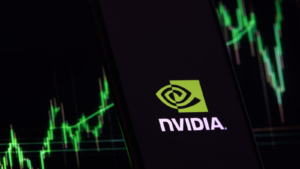April is off to a slower pace, with the index down 3% so far. Inflation reared its head again, putting in doubt when or if the Federal Reserve will cut interest rates. That could result in costs remaining high for businesses looking to finance their next growth project. That could mean Q1’s best-performing Nasdaq stocks won’t repeat in the second quarter. Or they could just shrug it off and continue on their merry way.
Let’s look closer and see if these top stocks will lead the way higher again for the next three months.
ASML Holding (ASML)

Artificial intelligence (AI) remained a driving theme for the best Nasdaq stocks, and Netherlands-based semiconductor equipment maker ASML Holding (NASDAQ:ASML) showed why it is a winning investment. It has a monopoly on making the critical equipment chipmakers need to manufacture AI chips in high demand.
ASML stock was up 33% in Q1 as investors understood the nature of the position it holds. The economy may slow, but the demand for AI technology will not be impeded anytime soon. Chipmakers already can’t keep up with demand, and that means they will require the sort of extreme ultraviolet lithography (EUV) machines only ASML sells.
In January, the equipment maker reported 2023 sales jumped 30% from the year before, achieving gross margins of 51%. ASML anticipates demand growing through 2025, and this year will be the first time ever it pre-builds its inventory in anticipation of the orders that flow through. While that could be risky if the orders don’t show up, ASML says AI, the electrification of mobility and a secular shift away from fossil fuels towards electrification will be long-term drivers of growth.
Whatever the future holds, it seems there is a very good chance that Q2 will look a lot like Q1 for ASML Holdings.
Micron Technology (MU)

Memory chipmaker Micron Technology (NASDAQ:MU) is getting swept up in the seismic shift created by AI demand. It is the premiere manufacturer of DRAM and NAND memory of the sort used in data centers, PCs, smartphones and other electronic equipment. The company announced in February that it began mass-producing high-bandwidth memory chips called HBM3E, made utilizing stacked DRAM technology. They provide more than 20 times the memory bandwidth of standard server modules with significantly lower power consumption. That’s key because of the memory hog that AI can become. MU stock jumped 40% in Q1.
Micron is the third-largest HBM manufacturer, though at a 5% market share, it greatly trails SK Hynix and Samsung, which have a 52% and 42% share, respectively. Micron, though, said in February the entirety of its 2024 HBM supply had already been sold, and most of its 2025 supply was gone too.
However, the earthquake that hit Taiwan on Apr. 3 will disrupt the chipmaker’s DRAM supply by mid-single-digit percentages. Micron said while there was no permanent damage to its factories in Taiwan and the long-term supply is unaffected, there will be a one-quarter setback. By the looks of it, there shouldn’t be too much disruption, but Q2 results may suffer slightly as a result.
Nvidia (NVDA)

To no one’s surprise, Nvidia (NASDAQ:NVDA) was repeating as a top-performing stock in the first quarter. Shares surged 77% above the level they started at in January. AI, of course, continues to be the fuel the chipmaker is pouring into its rocket engines.
As the top name in the powerful graphics processing units (GPU) delivering AI to customers, Nvidia continues to see outsized demand. Unlike Micron, however, Nvidia does not foresee any impact at all on its supply from the earthquake. The semiconductor stock supplies much of its chips from Taiwan Semiconductor Manufacturing (NYSE:TSM), and after consulting with them and others, was confident its chip supplies would remain unaffected.
That seems to bode well for Nvidia stock continuing its meteoric rise. Yet, like the broader index, the chipmaker’s stock has pulled back to start Q2, with shares down 3% in April. Nvidia does face rising competition for AI chips. Customers are looking to limit their exposure to Nvidia by developing chips in-house. Alphabet (NASDAQ:GOOG, NASDAQ:GOOGL), Amazon (NASDAQ:AMZN) and Apple (NASDAQ:AAPL) are all developing their own AI chips, and other manufacturers like Advanced Micro Devices (NASDAQ:AMD) and Intel (NASDAQ:INTC) have built powerful competing products.
There’s no reason to believe they will make inroads too far into Nvidia’s dominance, at least not anytime soon. But there could be a slowdown coming in the chipmaker’s future.
On the date of publication, Rich Duprey did not hold (either directly or indirectly) any positions in the securities mentioned in this article. The opinions expressed in this article are those of the writer, subject to the InvestorPlace.com Publishing Guidelines.
Rich Duprey has written about stocks and investing for the past 20 years. His articles have appeared on Nasdaq.com, The Motley Fool, and Yahoo! Finance, and he has been referenced by U.S. and international publications, including MarketWatch, Financial Times, Forbes, Fast Company, USA Today, Milwaukee Journal Sentinel, Cheddar News, The Boston Globe, L’Express, and numerous other news outlets.
